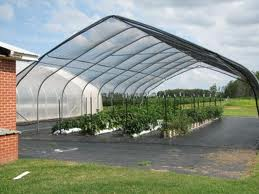
by Eddie Powell | Aug 12, 2014

Shade House for early fall crop
Credits: UF/IFAS
In fall, many Florida homeowners enjoy growing their own vegetables but are faced with late summer heat issues. This happens during the first few days of August here in north Florida. Most cole crops are recommended to be planted for the fall as early as August 1, but they must be protected from the hot weather or they may need to be replaced if hot weather damages them. A diverse selection of both heat-resistant and tender plants should be planted in order to prevent total devastation of the garden by extremely hot weather.
The site selection for tender plants should be number one on your list when protecting from heat. Fall vegetable plants need a site with good air flow to protect them from the early season hot temperatures. Arranging susceptible plants along a shade barrier can protect them from direct hot sun, especially from afternoon sun. Poorly drained soils result in weak shallow roots which are more susceptible to drying out during a heat wave.
Plants grown with the correctly applied rate of nutrients will tolerate hotter temperatures better and recover from wilt injury faster than plants grown with little to no nutrients. Watering vegetable garden plants early in the day can help protect them. A well-watered soil will stay cooler than a dry soil and keep plants hydrated. However, saturated soil conditions can damage the root systems of most plants over a few days, so make sure the ground is well-drained.
Healthy vegetable plants are more resistant to heat than vegetable plants weakened by disease, insect damage, or nematode damage. Routine inspection for pests and implementation of necessary control measures are essential. Feel free to contact your local county extension office for information on pest identification and recommended controls.
Shade cloth coverings can help protect vegetable plants more from extreme hot temperatures during the beginning of fall gardening. Shade Cloth that extend to the ground and are not in contact with the vegetable plants foliage can lessen heat injury to the plant. If the vegetable plant foliage is in contact with the cover it is often dried out or injured because of heat transfer from cover the foliage can burn the leaves. One example of excellent plant covers is shade cloth or even an old trampoline cover. To learn more on heat protection of vegetable plants call your local UF/IFAS Extension Service
by Matthew Orwat | Aug 4, 2014
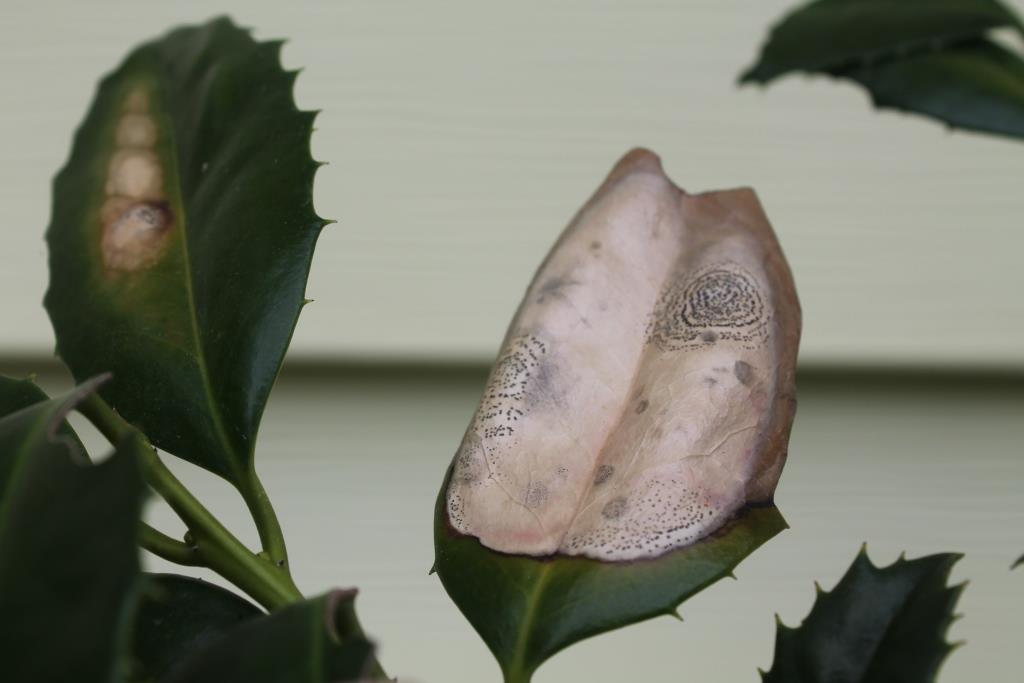
Holly leaf infected with Phyllosticta. Image Credit Matthew Orwat
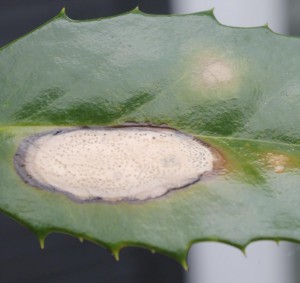
Phyllosticta lesion on holly leaf. Image Credit Matthew Orwat
The high humidity experienced in the Florida Panhandle during July and August has provided perfect conditions for fungal disease development on the leaves of a variety of ornamental species. One particularly noticeable pathogen is Phyllosticta. Fungi of the Phyllosticta spp. often cause large brown lesions on ornamental shrubs and trees such as magnolia, holly, Indian hawthorn, maple, crape myrtle and others. This dark to light brown spots are bordered with maroon, black or yellow rings, dividing the living and dead tissue. Black fruiting bodies, about the size of a pinpoint, are often spread throughout the diseased areas of the leaf. Infected portions of the leaf often drop out, leaving ragged remnants on formerly attractive shrubs.
Although preventative fungicides have been shown to reduce disease incidence, infected plants cannot be cured by sprays. Several mechanical strategies should be put into practice to reduce disease re-occurrence.
- Sanitation: Removal of leaf litter – Dead, diseased leaves contain the fruiting bodies, which will produce new fungal spores if left in the garden
- Thinning of branches – areas with poor air circulation are more prone to Phyllosticta
- Drip irrigation – overhead irrigation enhances the spread of a variety of fungal diseases. If overhead irrigation must be used, it should be done between 5 – 10 a.m.
For additional information about this and other disease, please go to the UF/IFAS U-Scout disease ID site.
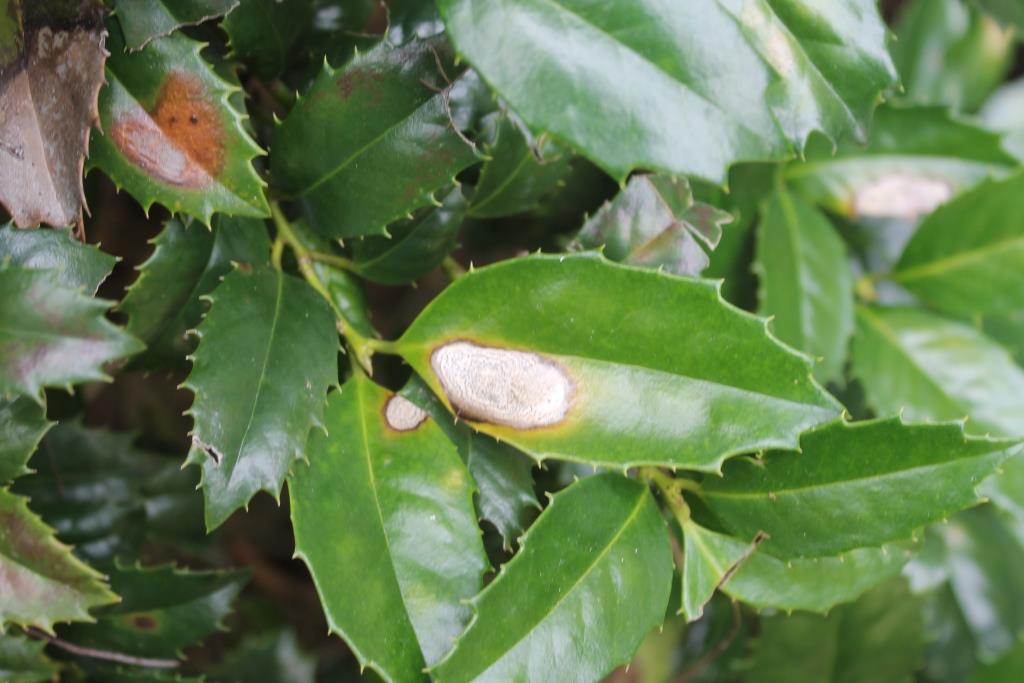
Early statge Phyllosticta. Image Credit Matthew Orwat
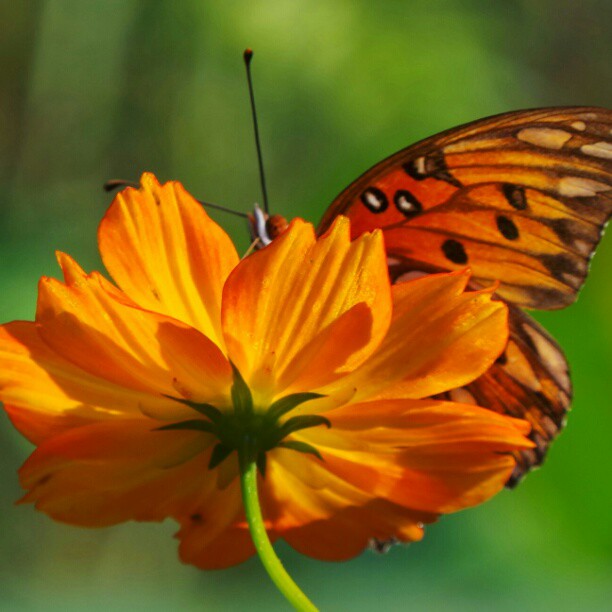
by Taylor Vandiver | Aug 4, 2014
Attracting Butterflies into Your Landscape
Have you been itching to add some life and color into your landscape? Why not plant a butterfly garden?! Butterfly gardens are a great way to add movement and life to an otherwise stagnant landscape. Most butterfly gardens are not only an attractant for our Florida butterflies, but are also a magnet for hummingbirds and beneficial insects. To start your garden all you need are a few key plants.
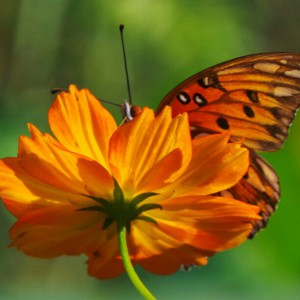
Gulf Fritillary. Photo Courtesy Scott Jackson.
Incorporate at least one host plant and one nectar plant into your garden. The host plant provides a suitable habitat for the female butterfly to lay her eggs. These eggs will hatch and the baby caterpillars will eat the leaves of the host plant. Host plants are often not as showy as nectar plants, nor are they even necessary to attract adult butterflies. However, while nectar plants invite butterflies into your garden to feed, host plants offer them a reason to stay and reproduce. And you can watch this entire cycle unfold in your own garden!
Most of your butterfly attractant plants will do best in full sun to partial shade. Try not to apply pesticides in areas where you want to maintain healthy caterpillar/butterfly populations. Providing water for butterflies is very important and easily done. One option is to fill a clay tray with sand and then place a rock in the center, where the butterfly can perch. Keep the sand wet, but avoid standing water. Feel free to contact your local extension office for more information on our winged friends!
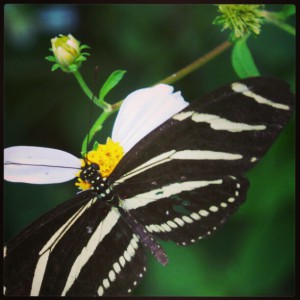
Zebra Longwing, our state butterfly! Photo courtesy Scott Jackson.
Here are a few examples of butterflies and their preferred host plants:
o Host Plants – Fennel, Parsley, Bishopsweed
o Host Plants – Pawpaw
o Host Plants – Wild Lime, Hercules-club, Citrus spp.
o Host Plants – Ash, Black Cherry, Tulip tree, Sweetbay Magnolia
o Host Plants – Partridge Pea, Cassia
o Host Plants – Passion Vines
- Zebra Longwing (State Butterfly of Florida)
o Host Plants – Passion Vines
o Host Plants – Milkweed, Butterfly Weed
Here are nectar plants that will have the butterflies swarming to your garden:
- Firebush
- Milkweed
- Blanket Flower
- Sage (Salvia spp.)
- Butterfly Bush
- Blazing Star
- Yarrow
- Pentas
- Stoke’s Aster

by Larry Williams | Aug 4, 2014
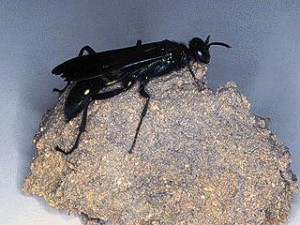
Mud dauber, Photo Credit: UF/IFAS Extension
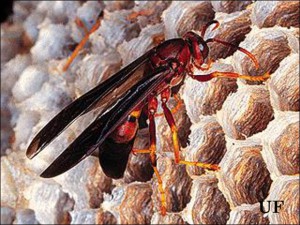
Paper wasp, Photo Credit: UF/IFAS Extension
I respect the fact that wasps can sting when threatened or disturbed. But I also respect the fact that they are beneficial.
Every time I’ve been stung by wasps, I either accidentally disturbed a nest that I didn’t know was there or I intentionally disturbed the nest and paid the price.
Paper wasps are common in Florida. They frequently construct and attach their paper-like nests to building eaves or the ceilings of porches. The adults seek out caterpillars, which they sting and paralyze. They then take the caterpillars back to their nest and place them in individual cells as food for the developing larvae.
I’ve witnessed the paper wasp as it stings and carries away a caterpillar from my vegetable garden. They are busy insects and are doing us gardeners a favor by reducing the population of caterpillars in our landscapes and gardens.
There are other beneficial wasps in Florida. Mud daubers, for example, build their mud-like nests on the sides of buildings close to human activity.
The mud dauber is not as aggressive as the paper wasp. It rarely stings people. It stings and paralyzes spiders. The mud dauber lays an egg on each paralyzed spider and seals it inside a chamber in its earthen nest. Upon hatching, the wasp larva feeds on the body of the spider. An emergence hole is made as the young wasp leaves the mud nest.
It may not be wise to tolerate all wasp species living in close proximity to your home. Even though yellow jackets, a type of wasp, could be considered beneficial, they are too aggressive and too likely to repeatedly sting to have as close neighbors. I also would be concerned with any type of wasp or bee nest existing in close proximity to individuals with a known allergy to insect stings.
Just because an insect has the ability to sting, it’s not all bad. Wasps can serve a beneficial purpose. But you’ll have to decide for yourself how close to you they can build their nests. The front porch may be too close.










